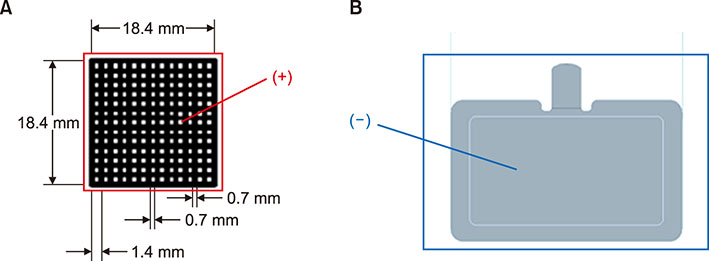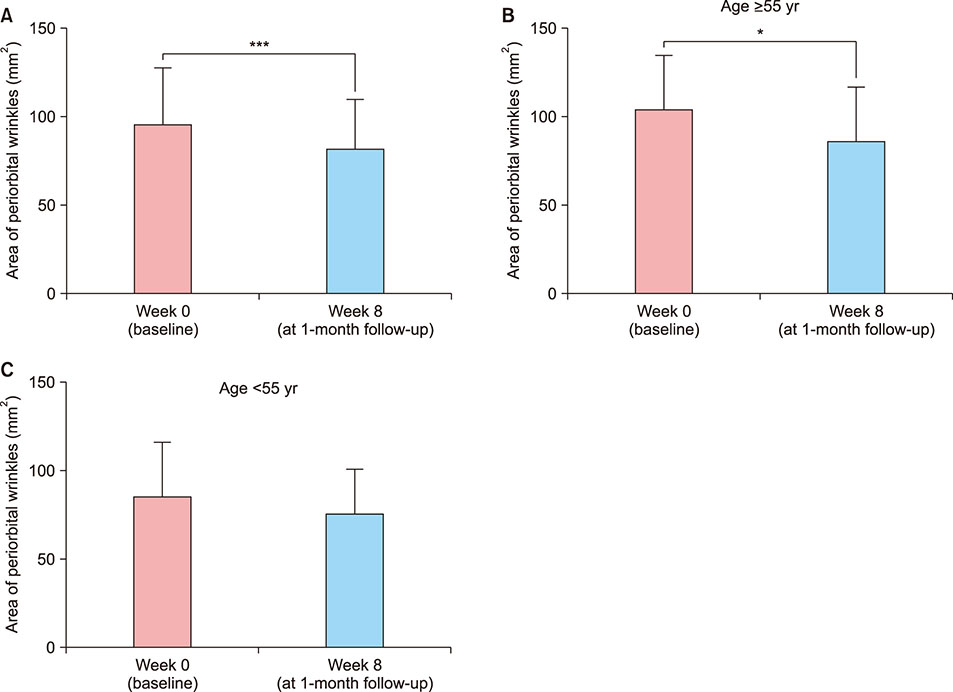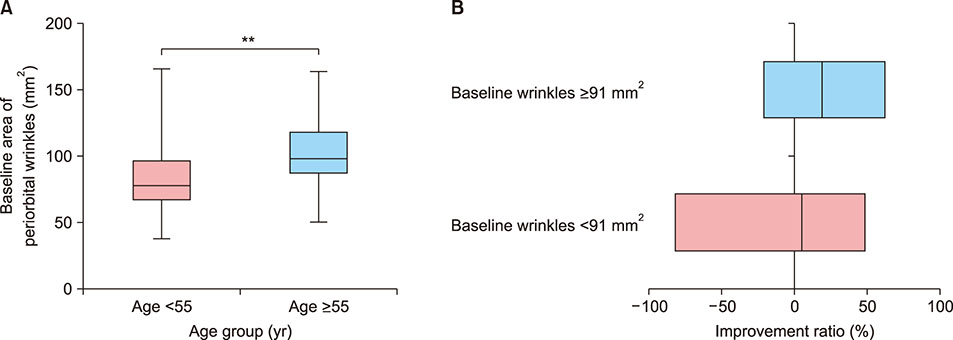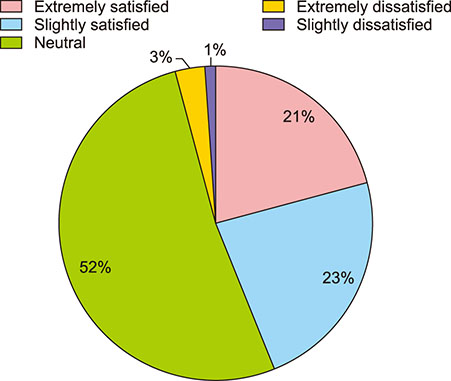Ann Dermatol.
2018 Jun;30(3):296-303. 10.5021/ad.2018.30.3.296.
Usefulness of Monopolar Thermal Radiofrequency Treatment for Periorbital Wrinkles
- Affiliations
-
- 1Department of Dermatology, Konkuk University School of Medicine, Seoul, Korea. kjahn@kuh.ac.kr
- 2Eunsung Global Corporation, Seoul, Korea.
- KMID: 2419170
- DOI: http://doi.org/10.5021/ad.2018.30.3.296
Abstract
- BACKGROUND
Over the past 10 years, monopolar radiofrequency (MRF) technology has been widely used by dermatologists as a valuable modality to effectively tighten and rejuvenate photoaged skin. It also has the benefit of a short recovery time.
OBJECTIVE
Using an objective parameter, this study aimed to assess the efficacy and safety of MRF, which is the basic modality of radiofrequency technologies, for treatment of periorbital wrinkles in Korean patients.
METHODS
We enrolled 70 middle-aged female patients with periorbital wrinkles for this study. Each patient underwent triple sessions of MRF treatment in the periorbital region, separated by 2-week intervals. Clinical photographs were obtained, and the areas of wrinkles were measured using a Robo Skin Analyzer CS50 (Inforward Inc., Japan) at baseline and 4 weeks after the final treatment session.
RESULTS
Significant reduction in the mean area of periorbital wrinkles was detected at 1-month follow-up (80.64±28.96 mm2) compared to baseline (95.08±31.93 mm2). The improvement ratio of the wrinkle area was 15.19%. Pain during procedure seemed to be tolerable without any local anesthesia for all patients. Transient mild erythema was the only side effect reported during the study.
CONCLUSION
In conclusion, MRF could still be an attractive modality for Korean patients with periorbital wrinkles if the treatment is conducted repeatedly with sufficient energy and proper intervals.
Figure
Reference
-
1. Lolis MS, Goldberg DJ. Radiofrequency in cosmetic dermatology: a review. Dermatol Surg. 2012; 38:1765–1776.
Article2. Atiyeh BS, Dibo SA. Nonsurgical nonablative treatment of aging skin: radiofrequency technologies between aggressive marketing and evidence-based efficacy. Aesthetic Plast Surg. 2009; 33:283–294.
Article3. el-Domyati M, el-Ammawi TS, Medhat W, Moawad O, Brennan D, Mahoney MG, et al. Radiofrequency facial rejuvenation: evidence-based effect. J Am Acad Dermatol. 2011; 64:524–535.
Article4. Taub AF, Tucker RD, Palange A. Facial tightening with an advanced 4-MHz monopolar radiofrequency device. J Drugs Dermatol. 2012; 11:1288–1294.5. Alster TS, Lupton JR. Nonablative cutaneous remodeling using radiofrequency devices. Clin Dermatol. 2007; 25:487–491.
Article6. Fisher GH, Jacobson LG, Bernstein LJ, Kim KH, Geronemus RG. Nonablative radiofrequency treatment of facial laxity. Dermatol Surg. 2005; 31:1237–1241. discussion 1241.
Article7. Kawada A, Konishi N, Momma T, Oiso N, Kawara S. Evaluation of anti-wrinkle effects of a novel cosmetic containing retinol using the guideline of the Japan Cosmetic Industry Association. J Dermatol. 2009; 36:583–586.
Article8. Javate RM, Cruz RT Jr, Khan J, Trakos N, Gordon RE. Nonablative 4-MHz dual radiofrequency wand rejuvenation treatment for periorbital rhytides and midface laxity. Ophthal Plast Reconstr Surg. 2011; 27:180–185.
Article9. Kim H, Park KY, Choi SY, Koh HJ, Park SY, Park WS, et al. The efficacy, longevity, and safety of combined radiofrequency treatment and hyaluronic Acid filler for skin rejuvenation. Ann Dermatol. 2014; 26:447–456.
Article10. Elsaie ML, Choudhary S, Leiva A, Nouri K. Nonablative radiofrequency for skin rejuvenation. Dermatol Surg. 2010; 36:577–589.
Article11. Abraham MT, Vic Ross E. Current concepts in nonablative radiofrequency rejuvenation of the lower face and neck. Facial Plast Surg. 2005; 21:65–73.
Article12. Bassichis BA, Dayan S, Thomas JR. Use of a nonablative radiofrequency device to rejuvenate the upper one-third of the face. Otolaryngol Head Neck Surg. 2004; 130:397–406.
Article13. Mulholland RS. Radio frequency energy for non-invasive and minimally invasive skin tightening. Clin Plast Surg. 2011; 38:437–448, vi.
Article14. Polder KD, Bruce S. Radiofrequency: thermage. Facial Plast Surg Clin North Am. 2011; 19:347–359.
Article15. Biesman BS, Pope K. Monopolar radiofrequency treatment of the eyelids: a safety evaluation. Dermatol Surg. 2007; 33:794–801.
Article16. Sadick NS, Nassar AH, Dorizas AS, Alexiades-Armenakas M. Bipolar and multipolar radiofrequency. Dermatol Surg. 2014; 40 Suppl 12. S174–S179.
Article17. Fitzpatrick R, Geronemus R, Goldberg D, Kaminer M, Kilmer S, Ruiz-Esparza J. Multicenter study of noninvasive radiofrequency for periorbital tissue tightening. Lasers Surg Med. 2003; 33:232–242.
Article18. Nahm WK, Su TT, Rotunda AM, Moy RL. Objective changes in brow position, superior palpebral crease, peak angle of the eyebrow, and jowl surface area after volumetric radiofrequency treatments to half of the face. Dermatol Surg. 2004; 30:922–928. discussion 928.
Article19. Suh DH, Lee SJ, Ryou JH, Son HC, Kim HJ, Kim HS. Monopolar radiofrequency treatment in Asian skin: do multiple RF treatments over time have beneficial effects? An observational report with long-term follow-up in eight patients. Dermatol Surg. 2013; 39:670–672.
Article20. Kakudo N, Kushida S, Tanaka N, Minakata T, Suzuki K, Kusumoto K. A novel method to measure conspicuous facial pores using computer analysis of digital-camera-captured images: the effect of glycolic acid chemical peeling. Skin Res Technol. 2011; 17:427–433.
Article21. Kim JK, Roh MR, Park GH, Kim YJ, Jeon IK, Chang SE. Fractionated microneedle radiofrequency for the treatment of periorbital wrinkles. J Dermatol. 2013; 40:172–176.
Article
- Full Text Links
- Actions
-
Cited
- CITED
-
- Close
- Share
- Similar articles
-
- Periorbital Skin Rejuvenation of Asian Skin Using Microneedle Fractional Radiofrequency
- Skin tightening effecacy and safety: high-intensity focused ultrasound alone or in combination with monopolar radiofreqeuncy treatment in Republic of Korea: retrospective clinical study
- Skin Burn after Laparoscopic Radiofrequency Thermal Ablation for Uterine Myoma : A case report
- A Comparative Experimental Study of the, In-vitro Efficiency of Hypertonic, Saline-Enhanced Hepatic Bipolar and, Monopolar Radiofrequency Ablation
- Usefulness of Gold Thread Implantation for Crow's Feet







